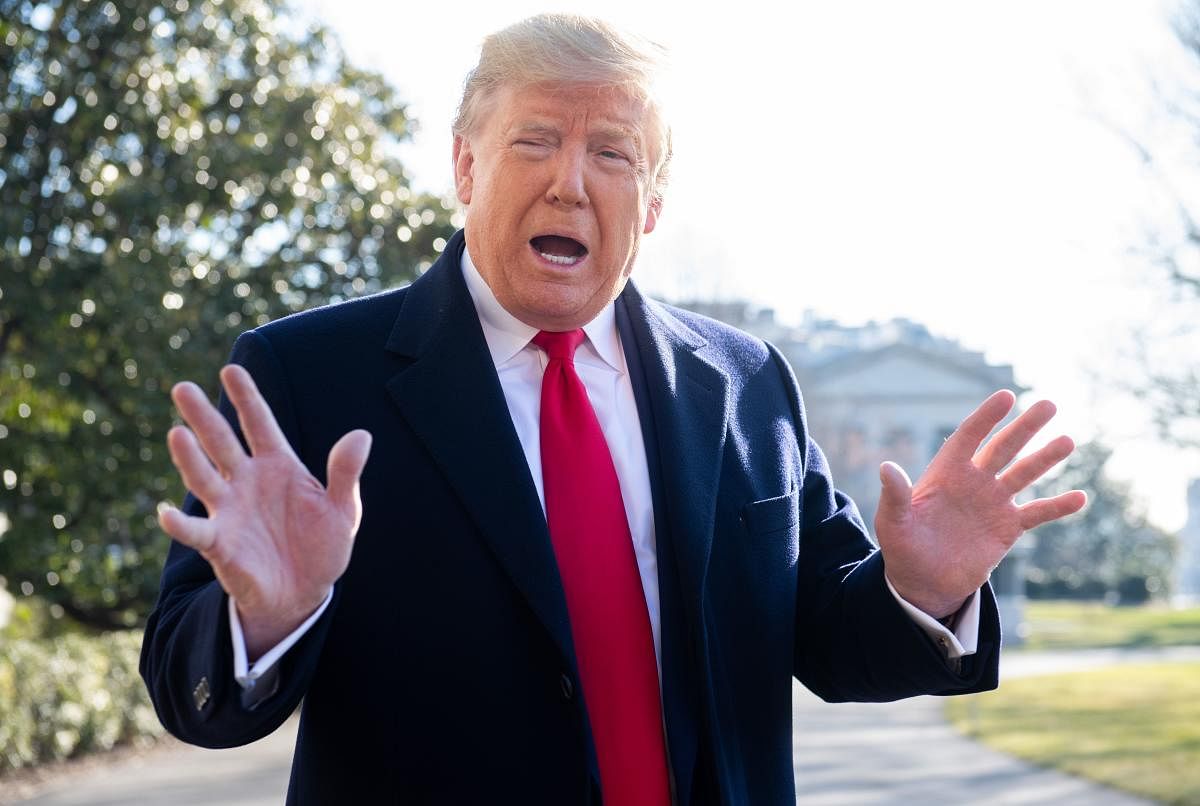
US President Donald Trump anticipates a hero’s welcome in India on Monday, but the glitzy events filling his two-day visit with Prime Minister Narendra Modi will paper over growing trade frictions.
The visit is intended to strengthen the personal relationship between Trump and Modi, a fellow nationalist whose country is regarded by the US as an important regional counterweight against China. And for Modi, the visit may distract from controversies over a new citizenship law that his critics say discriminates against Muslims, as well as a souring domestic economy.
Trump, with his re-election campaign in top gear, has sought out large, friendly crowds at football games, professional fights and the biggest auto race in America to ensure he’s never far from the minds of American voters.
Modi plans to provide Trump with a similar spectacle on Monday in Ahmedabad in the prime minister’s home state of Gujarat. Trump says the Indian leader has promised that millions of people will line 22 kilometers (13.7 miles) of roads between the airport and a new, 110,000-seat cricket stadium where both leaders will speak just after noon local time.
The event is billed as “Namaste Trump” and is to be followed by a presidential visit to the Taj Mahal in Agra before official meetings on Tuesday.
‘Showy Distraction’
“The visit is a low-risk and characteristically showy distraction from domestic controversies” for the populist leaders, Ian Hall, professor at Griffith University in Queensland, Australia, and author of the 2019 book “Modi and the Reinvention of Indian Foreign Policy,” said via email.
Indian Foreign Secretary Harsh Vardhan Shringla said last week that “tens of thousands” of onlookers and artists showcasing performing arts from different states and territories are expected to greet the president in Ahmedabad.
Trump predicted that the crowds in India will make his domestic campaign rallies, typically attended by 10,000 to 20,000 people, “look like peanuts from now on.”
The president’s visit might boost his appeal among Indian American voters, an emerging voting bloc in the US that has traditionally backed Democrats. Trump compared Modi to Elvis Presley last year after “Howdy Modi,” a Houston event arranged for the prime minister’s visit that drew about 50,000 Indian Americans.
‘A Modest Dividend’
“Politically I’m sure there’s at least a modest dividend to be achieved on that,” Richard M. Rossow, an India expert at the Center for Strategic and International Studies, told reporters at a briefing.
But India’s red-carpet treatment of Trump, which includes the construction of a 1,640 foot-long wall to hide a slum from view along Trump’s motorcade route, as well as a state dinner, belies a simmering trade dispute.
While their security and political partnership remains close, the US and India have slapped retaliatory tariffs on each others’ imports.
Officials have tried to hammer out a modest trade deal opening up India to US agricultural products and medical devices in return for the restoration of preferential export status that Trump stripped from India in 2019.
Chances a deal would be announced soon appeared to dim when US Trade Representative Robert Lighthizer scrapped a planned visit to India, according to people familiar with the negotiations.
“We’re going to India, and we may make a tremendous deal there, or maybe we’ll slow it down. We’ll do it after the election,” Trump said at an event on Thursday in Las Vegas.
Top White House economic adviser Larry Kudlow on Friday said he doesn’t expect “a big trade component in this visit,” and called on India to open its markets to direct foreign investment and the “normal” trading of goods and services.
“I don’t expect any details or much progress at all,” Kudlow said on Fox News.
Rossow said Trump and Modi may announce an agreement on a few narrow trade issues. That could include a reduction of Indian tariffs on Harley-Davidson Inc. motorcycles, a US company Trump has championed.
The leaders are expected to deepen their nations’ defense ties, with the possible announcement of India’s $2.6 billion purchase of Lockheed Martin Corp. naval helicopters. The State Department has also approved a potential sale to India of $1.8 billion in arms, including air-defense radars and missiles, rifles and other equipment, the US Defense Security Cooperation Agency announced.
Citizenship Law
The US has sought to become a top arms supplier to India, the world’s fourth-biggest defense spender, and elbow out Russia. Washington has pushed New Delhi, unsuccessfully so far, to cancel a contract worth more than $5 billion to buy Russia’s S-400 air-defense missile system.
Modi’s domestic controversies are a potential minefield for both leaders. His new religion-based citizenship law sparked large protests, and his government has lost three consecutive state elections including in the Indian capital. He’s also suffered criticism for an attempt to enforce Indian sovereignty over the disputed territory of Kashmir.
The Trump administration has had little to say about the law, which allows undocumented immigrants from neighbouring countries to seek citizenship as long as they aren’t Muslim. Modi may gain political capital if Trump remains relatively silent on both the law and Kashmir, Hall said. A senior administration official said Friday, though, that Trump plans to press Modi on the topic of religious freedom.
“Modi will derive a bigger dividend from this trip than Trump, because of the distraction it offers from the domestic controversies, but also because the Indian public simply cares a great deal more about international opinion than its American counterpart,” said Hall, the Australian professor.
But Trump could cause headaches for Modi if he repeats an offer to mediate over Kashmir, a region divided between India and Pakistan. India has rejected the offer, while Pakistan’s Prime Minister Imran Khan has expressed frustration over Trump’s visit to India and meetings with Modi.